Chemical Carcinogenesis - Toxicology slide 3
1/89
Earn XP
Description and Tags
Taught by Dr. Thomas Visalli; 1:48min
Name | Mastery | Learn | Test | Matching | Spaced |
|---|
No study sessions yet.
90 Terms
Tumor
space occupying lesion that may or may nor be neoplastic
Neoplasm
an independent growth of tissue with abnormal regulation of gene expression; benign or malignant
Benign neoplasm
a non-cancerous tumor that grows slowly and does not spread to other parts of the body
Malignant Neoplasm
has the ability to metastasize; an abnormal growth of cells that has the potential to invade and spread to other parts of the body
Metastases
secondary growths of cells from the primary neoplasm
Cancer
a subset of malignant neoplastic lesions(neoplasms); Malignant Neoplasm
carcinogen
an agent that causes or induces neoplasia
what is the long definition of a carcinogen?
An agent whose administration to previously untreated animals leads to a statistically significant increased incidence of neoplasms of one or more histogenetic types compared with the incidence in appropriate untreated animals
carcinoma
malignant tumor arising in the epithelium; usually spreads via lymphatic system
what is the most common form of cancer?
carcinoma
sarcoma
malignant tumor arising in muscle or connective tissue; usually spreads via circulation
carcinogenesis can be caused by what kind of chemicals?
organic
polycyclic aromatic hydrocarbons (PAHs)
Nitrosamines
inorganic
cadmium
nickel
lead
arsenic
Hormonal
over production or derangement
Mixtures (defined/undefined)
tobacco smoke
Diesel exhausts
Diet
excessive caloric intake
excessive alcohol intake
aflatoxin B1
what is a common trait in almost all the carcinogenic molecules
they contain a nitrogen group, nitrogen is very good at interacting with DNA
what is the most often mechanism of chemical carcinogenesis
covalent interaction of chemicals with biological macromolecules(DNA) is required for chemical induction of cancer
pro-carcinogens
compounds that require metabolic alteration(activation) to a metabolite that is capable of covalent binding
Ultimate carcinogens
Highly reactive metabolites; final form of the carcinogen
what is caner in basic terms?
dysregulated cell growth
Mutagenesis
structural DNA alteration and cell proliferation that “fixes”(establishes) the DNA damage; The damage will become part of the DNA from now on and other cells will have it too
example of mutagenesis
DNA adduct formation- when a toxin binds to DNA and will cause errors in the DNA during replication, future copies of that cell will also have the errors
Mechanisms of chemical carcinogenesis
inhibition of DNA methylation
macromolecular adducts
Free radicals
crosslinking of DNA strands
Thymine dimers
Single and Double strand breaks
macromolecular adducts
covalent binding of the ultimate carcinogen to DNA, this usually happens in the the N7 position of guanine
what is the most nucleophilic site in DNA?
N7 position of guanine
adducts
the combined molecule of the toxin and usually DNA
what can adducts be produced?
on bases, sugars, and phosphate backbone
Free Radicals
elements which possess an unpaired electron
Free Radicals are created during?
metabolism of carcinogens
Free Radicals reacts with?
DNA to cause structural changes in bases
Inhibition of DNA methylation
preventing the methylation of genes on DNA
Inhibition of DNA methylation with result in what happening?
Causes excessive transcription of a rarely transcribed gene
In normal environment, genes that are hypomethylated
actively transcribed
In normal environment, genes that are hypermethylated
rarely transcribed
Crosslinking of DNA strands
crossing reaction of 2 opposing bases, can result in errors when that DNA is replicated; results from some chemical compounds
Thymine dimers
when 2 thymine components interact which can cause replication issues where errors can occur; common result of UV exposure
Single and double strand breaks
breaks the strands in DNA, messing with how it interacts with replication resulting in possible errors
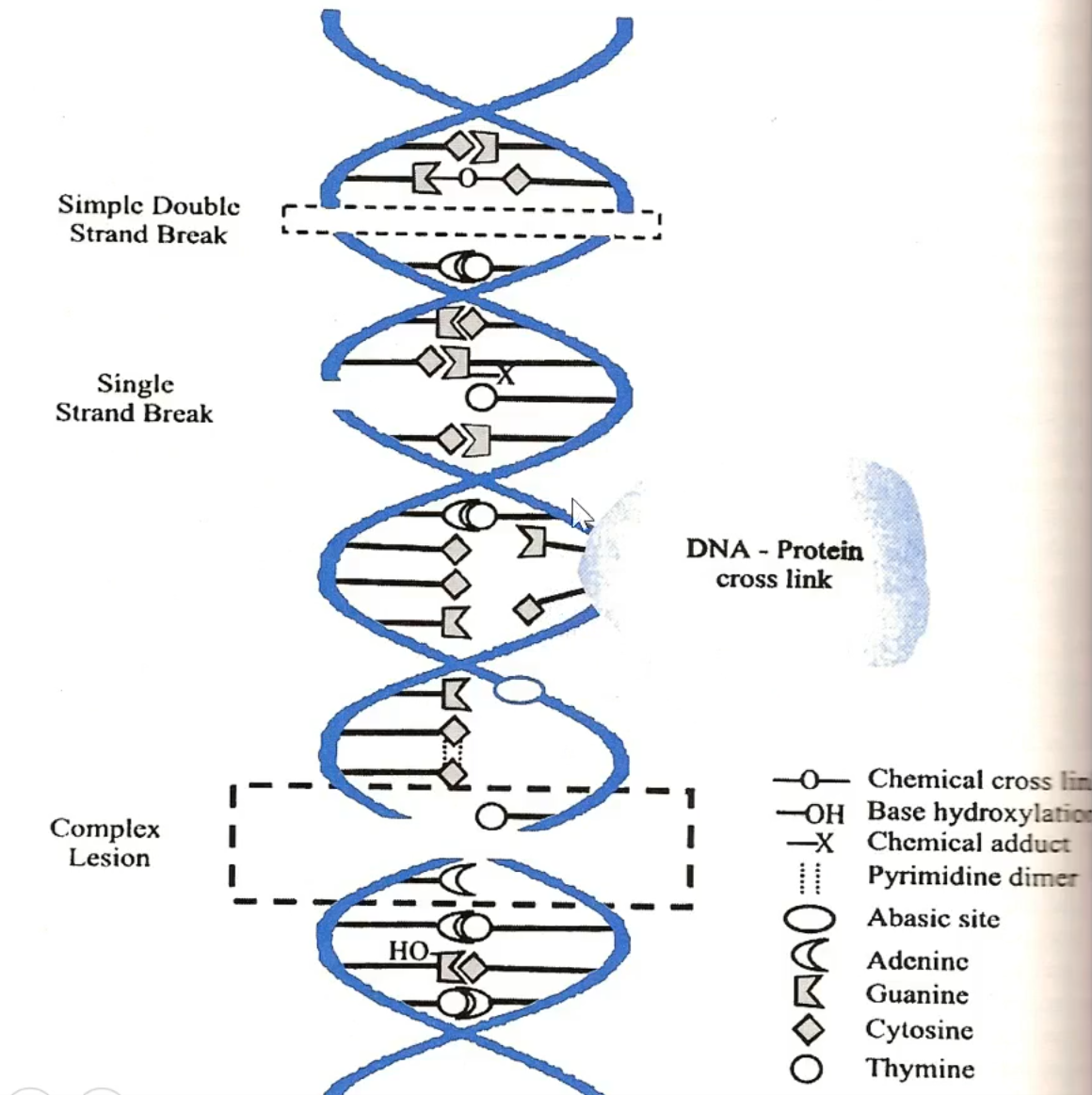
what does this diagram display/represent?
visual representations of the different mechanisms of carcinogenesis
what are the 2 types of mechanisms of DNA repair
Repair pathways
Tolerance mechanisms
Repair pathways
Damage removed or revered
adducts removed and new bases inserted
what are the 2 repair pathways
Base Excision Repair
Nucleotide Excision Repair
Base Excision Repair
repaired a small amount of damage; Removal of a single altered base with a low molecular weight adduct
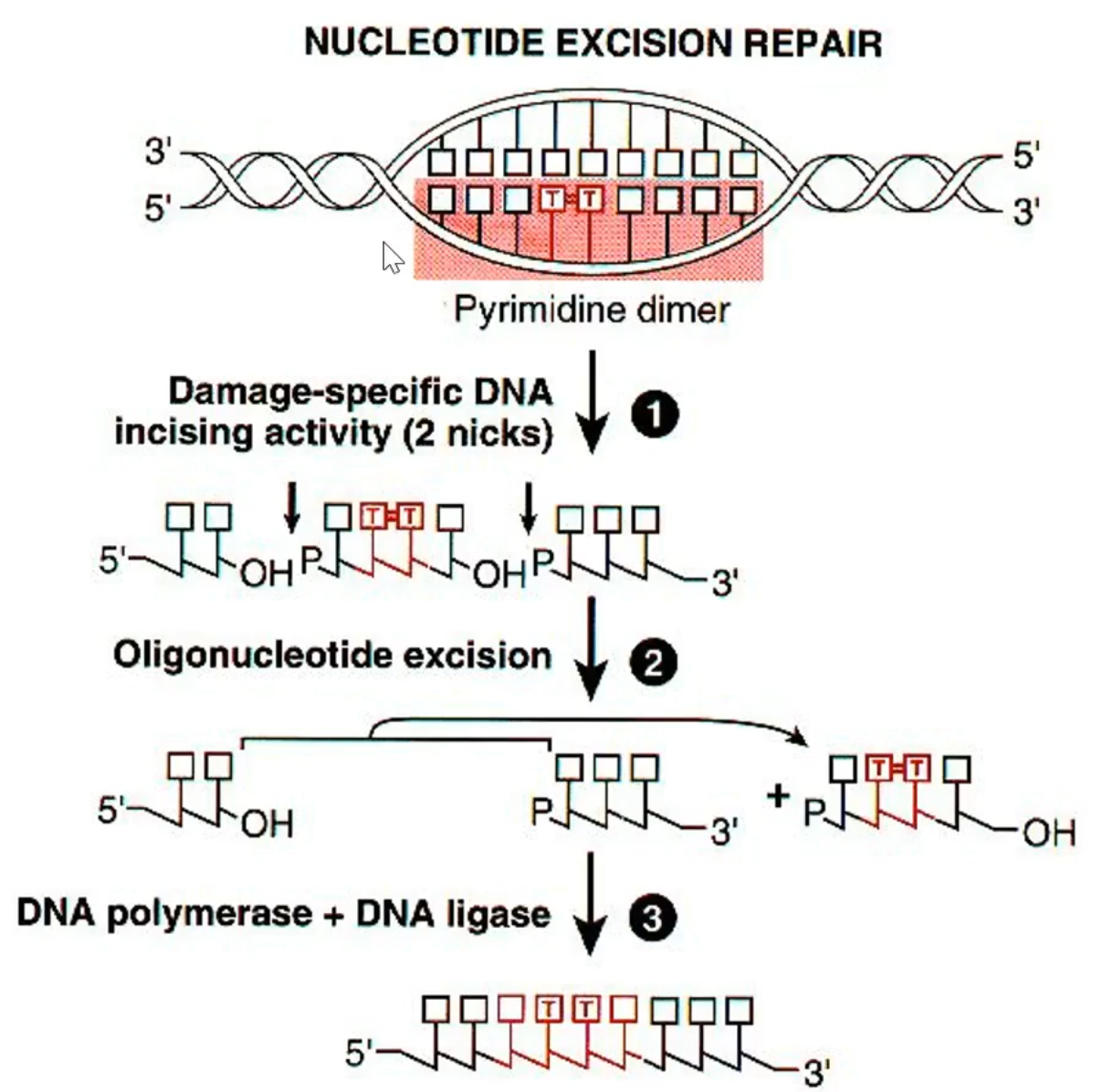
Nucleotide Excision Repair
Repairs a larger amount of damage
Removal of a base with a large adduct, or adduct effecting multiple bases
Potential for resultant mutations when large amount are repaired
Tolerance mechanisms
Damage circumvented and not repaired
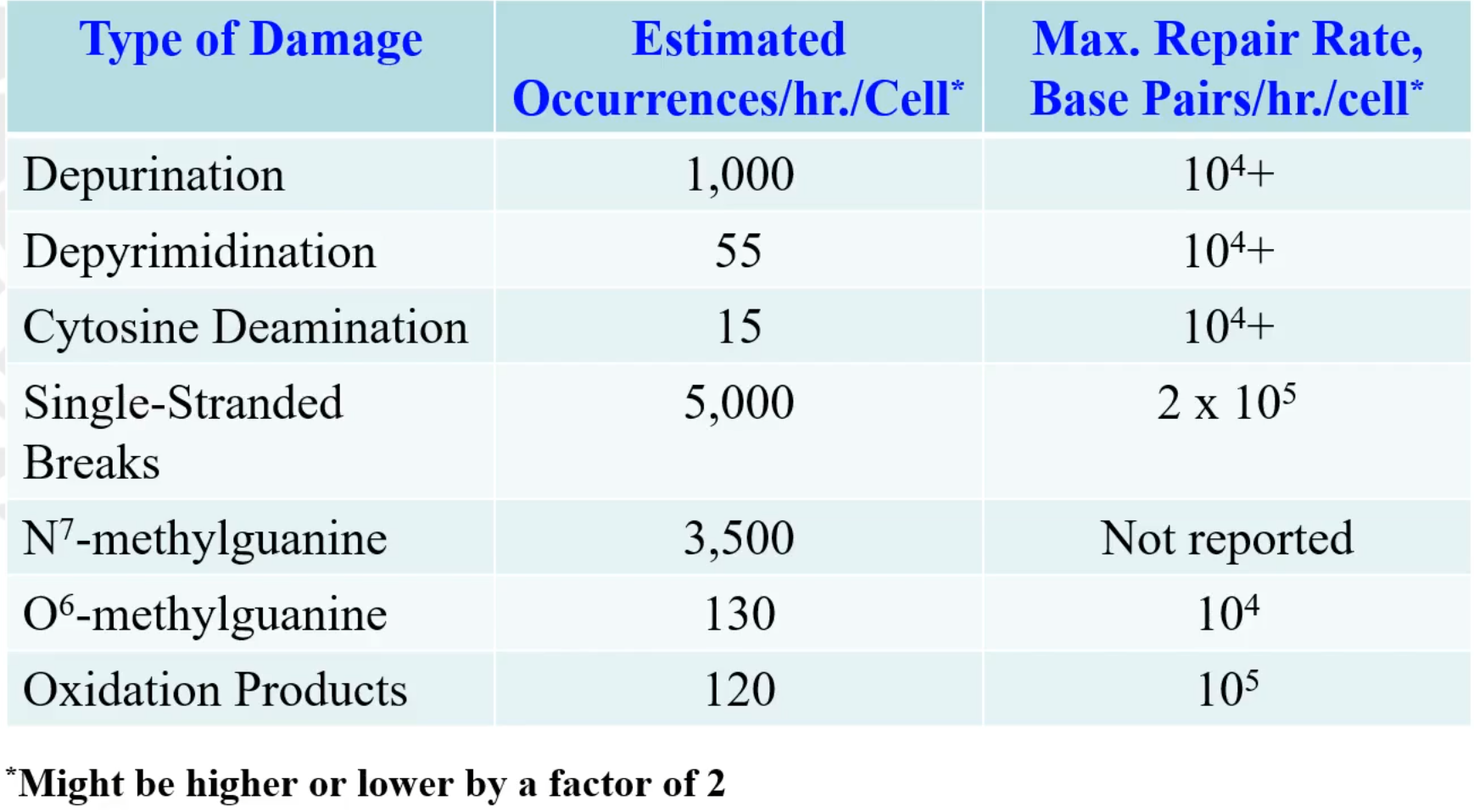
what does this diagram tell you?
Even though damage to DNA is a concern the rate of repair is still far greater in the cell, still, the more repair that is done the more likely mutations can happen
T/F carcinogenesis develops very quickly
False, it develops slowly; think of how fast it take for smokes to get chancer, etc
why does carcinogenesis develop slowly?
Long latency period between initial exposure to carcinogen and ultimate development of malignant neoplasia
Process of Neoplastic Development
Stage 1: initiation
Structural changes in DNA observed
Stage 2: promotion
No structural changes
Altered expression of genes
stage 3: Progression
Structural changes in DNA observed
Initiation (Stage 1)
Requires one or more rounds of cell division for “fixation” of the process resulting in a initiated cell if the genetic change sticks; spontaneous imitation of cells in a variety of tissue is very common
Initiation (Stage 1) - reversable of irreversible?
irreversible
what does Irreversible mean in the context of process of Neoplastic development?
even if the chemical that caused the damage is not present anymore, the damage will remain
what does reversible mean in the context of process of Neoplastic development?
If the chemical is removed, the damage would leave with it
T/F All initiated cells survive
False, not all survive; apoptosis, cell get repaired, immune system fights the cell, etc
Promotion (stage 2)
promoting agents that do not directly interact with the cell which depends on continued administration of the promoting agent
Initiation (Stage 1) - reversable of irreversible?
reversible
what happened when the promoter agent is removed?
Regression may occur; apoptosis of affected cells. Re-modeling of affected cells
what are examples of promoters?
Chemicals that may interact with receptors, mimicking their natural ligands
initiate cascades of promoting agents that exert effects on gene expression
Some promoters inhibit apoptosis
Relative potency of a promoter is measured?
by its effectiveness in causing an expansion of cell progeny of the initiated population
T/F The effect of the promotor agent is proportional to the number of receptors occupied by that chemical “ligand” and withdrawal of the promoting agent returns system to its original state
True
Progression (stage 3)
exposure of a substance that fosters continuing evolution of unstable cells, causes higher rate of cellular growth, alters bodies response to hormones usually leading to continued cell division, Ectopic hormone production
Ectopic hormone production
hormones that are produced in the wrong location or should be produced at the time
what can progression (stage 3) lead to?
invasive malignant disease
summary of initiation agent
(incomplete carcinogen) a chemical capable only of initiating cells
summary of promoting agent
a chemical capable of causing the expansion of initiated cell clones
summary of progressor agent
a chemical capable of converting an initiated cell or a cell in the stage of promotion to a potentially malignant cell
complete carcinogen
a chemical possessing the capability of inducing cancer from normal cells, usually possessing properties of initiating, promoting, and progressor agents
even though our body is able to take care of damaged cells why does cancer still take place
The more a person get exposed to carcinogens(of any or all stages) the more it builds up and cancer taking place, people are exposed to chemicals all the time and additional exposure for different lifestyle choices can increase the chances of cancer
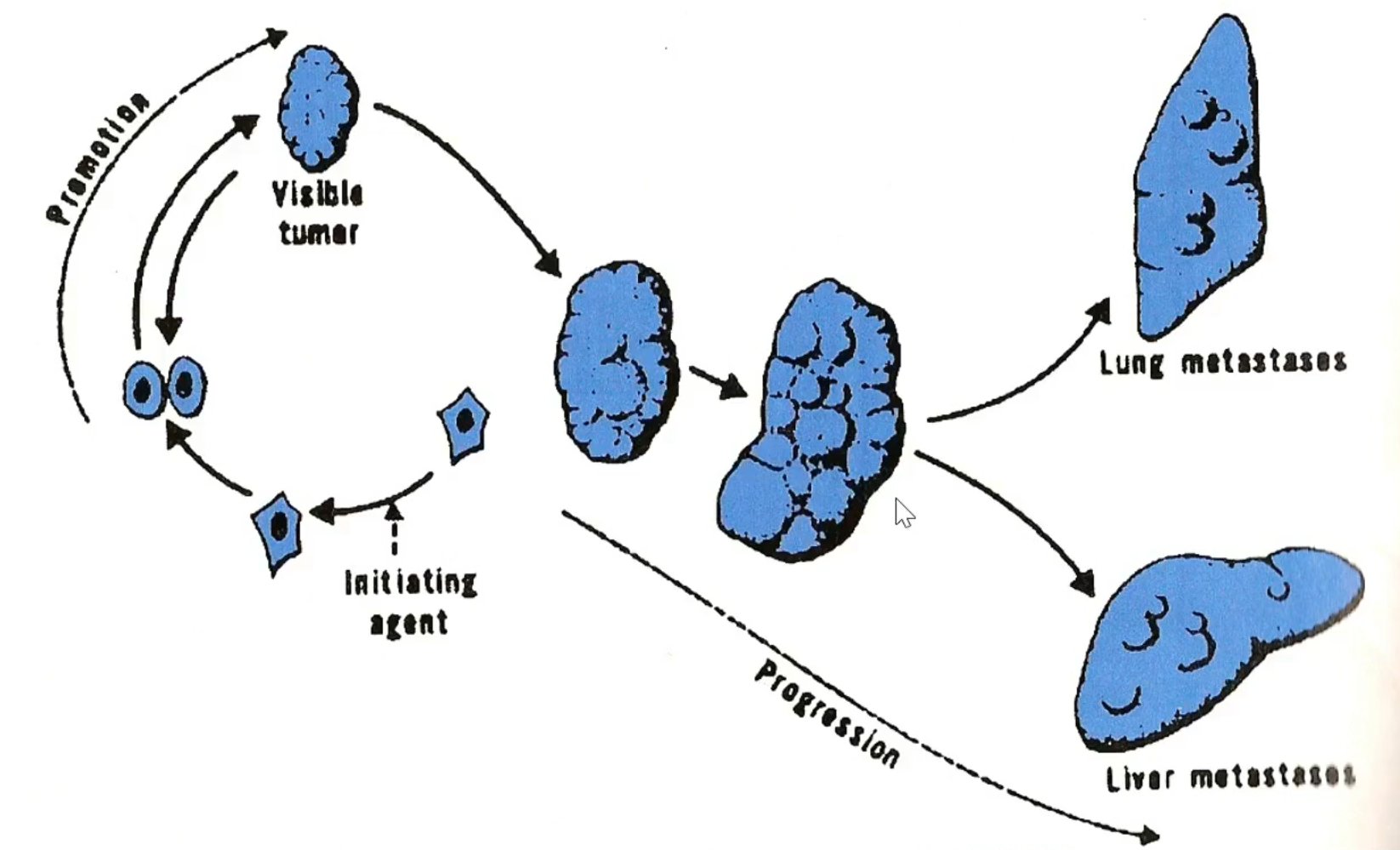
what does this diagram show you?
A visual representation of the different stages and how cancer can arise
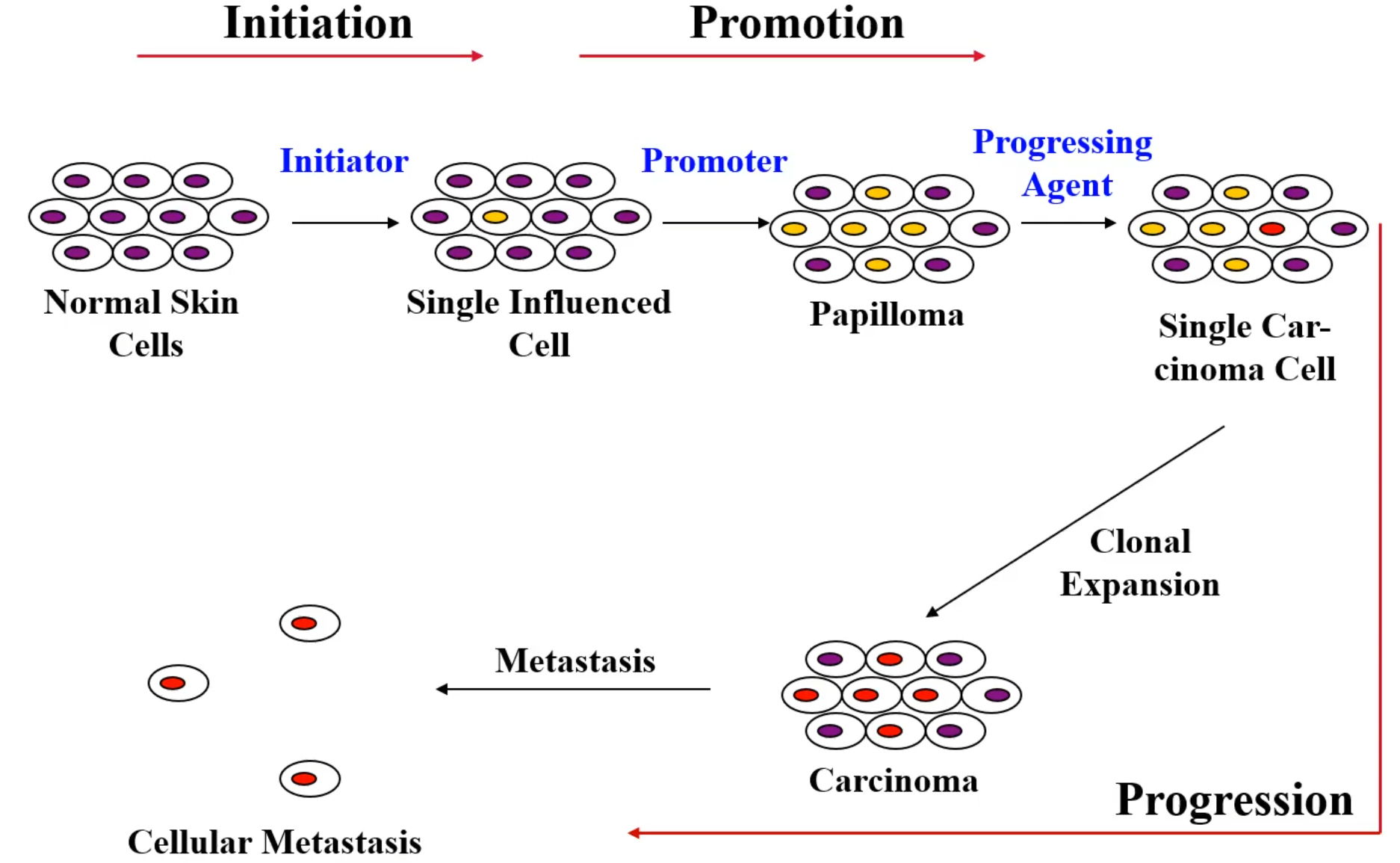
what does this diagram show you?
A visual representation of the different stages and how cancer can arise
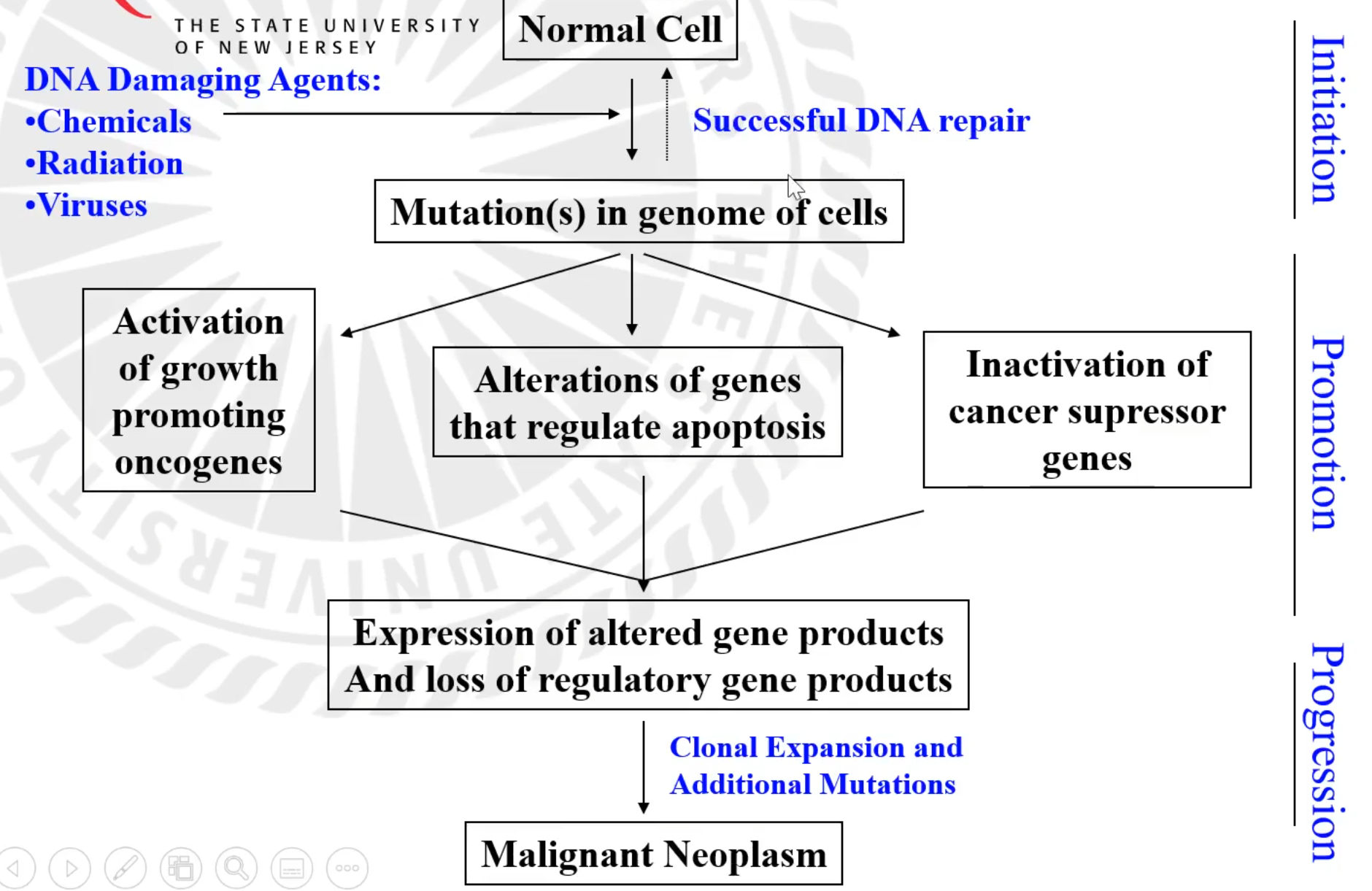
What does this diagram display?
explains neoplastic development in another way
what is a examples of cancer suppressor gene?
p53 genes
Epidemiology
Study of distribution and determinants of disease from observation rather than through controlled experimentation
how do we determine if a chemical causes carcinogenesis in humans?
epidemiology but it often is insufficient, rarely possible to identify a single chemical as sole carcinogen; there are numerous environmental variables, there is a long time interval between exposure and neoplasm development
International Agency for Research on Cancer (IARC)
provided system of definitions of relative carcinogenicity
what are the definitions provided by the IARC?
Sufficient Evidence
Limited Evidence
Inadequate Evidence
Sufficient Evidence
causal relationship between agent and human cancer
Limited Evidence
Causal interpretation is credible by alternative explanation can’t be excluded
Inadequate Evidence
Few pertinent data. Available studies don’t exclude chance, bias, variables
since epidemiology alone is not sufficient, what else is done?
Laboratory studies, in vitro and in vivo; also used to determine carcinogenicity of potential therapeutic compounds
examples of lifestyle carcinogenesis
alcoholic beverages
metabolized into acetaldehyde. contributes to progression
Dietary intake
carbohydrates and lipids may be promoting agents
Aflatoxins
complete carcinogens
Tobacco Use
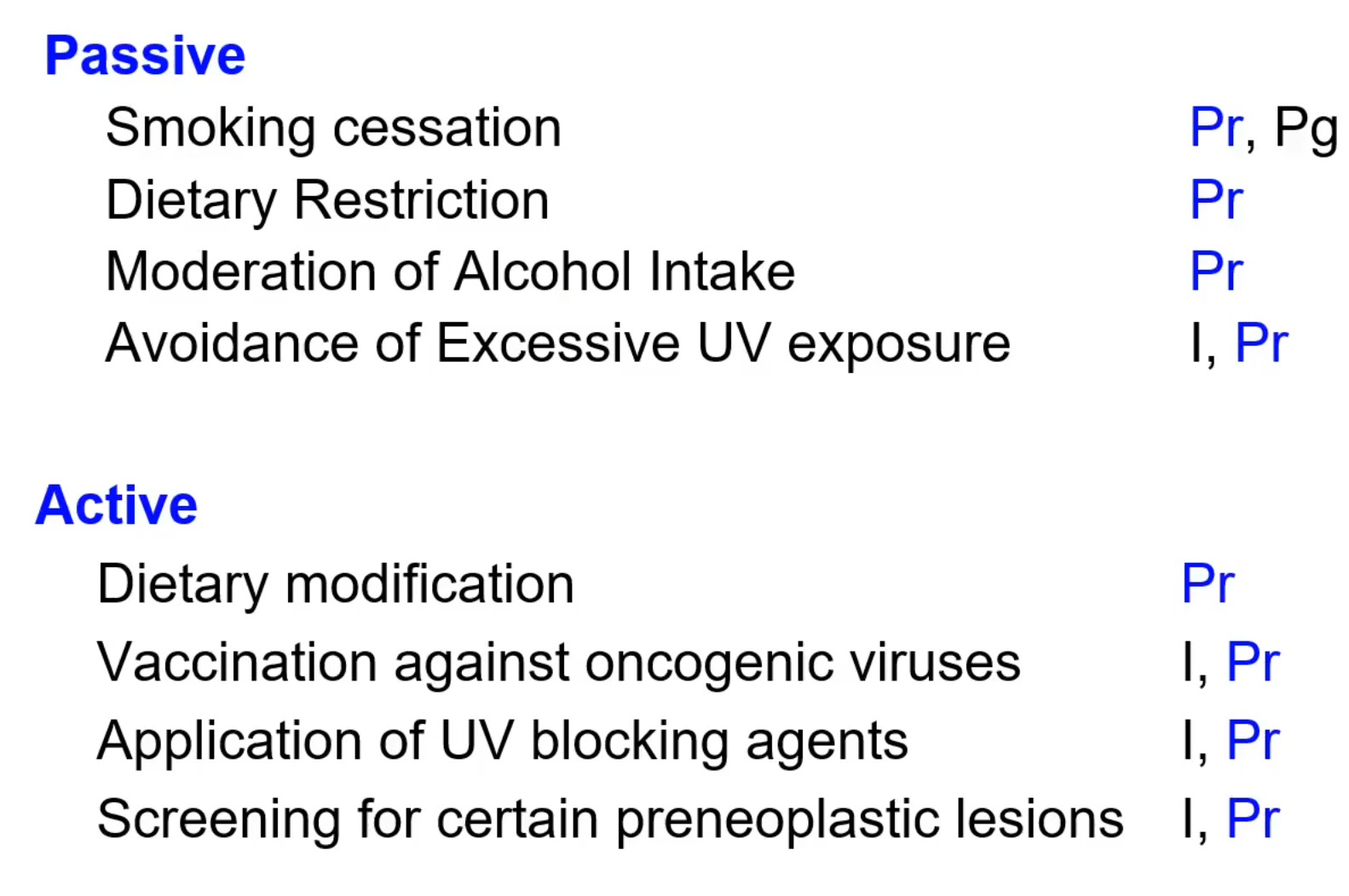
what does this chart show?
things that a person can do that can help in preventing cancer
(I- Initialization, Pr- promotion, Pg - progression)
how are assays classified?
short-term tests
medium-term tests
long-term tests
short-term testing
identify carcinogenic agents based on their capacity to induce mutations in DNA in cells in vitro or in vivo
e.g.
in silico analysis (SAR - structure activity relationship) - computer program that looks at structure and tells u if carcinogenic (DEREK M-case)
Ames test - gold standard for screening, required test for pharmaceutical compounds
Ames test
the test consists of salmonella typhinmurium cells which are deficient in DNA repair and lack ability to grow in absence of histidine, these cells are treated with the suspected carcinogen, if the cell grows on the plate with the suspected chemical that means a mutation took place allowing it to grow; 80% accuracy
what is S9 extract?
liver extract from rates that is put in the mixture that contains a lot of the metabolizing enzymes; allows you to know if the chemical needs to be metabolized first to be carcinogenic or no, you can run both with and without S9 to know both
Example of in Vivo, short-term test
Dominant lethal assay
male mice exposed to carcinogen, mated with untreated female mice, % pregnancy determined against a control population
Long-term in vivo study
Chronic 2-year study - gold standard
50 rodents/sex/dose level at 3 dose level
FDA must approve protocol
comparing a control group of the mice and 1 that was exposed to a chemical and see the spectrum of tumors and their incidence
the use of transgenic mice (p53 knockouts) can also be employed
1:39:00
1:39:00